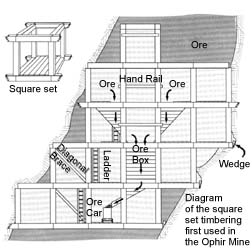Science of the Comstock - Physics
Home | Tour | Physics | Chemistry | Earth Science | Environment | Scams | Lesson Plans
Physics Topics:
Introduction
Siphons
Timbering
Timbering
When a mine is developed, rock is removed from the Earth. Miners make tunnels to remove rock that contains valuable minerals, and they also make some tunnels just to get to the rich ore. Sometimes the rock containing valuable minerals is not just along the line of a tunnel but forms a large body. Miners then need to remove so much rock that a large room several stories high is formed. However, mines in rock can collapse just like tunnels that children sometimes make in sand piles. Miners must reinforce the tunnels and rooms so that the walls and roof do not fall in. Mine timbering is a process in which wood or steel is used to support the wall and roof of a mine.
By the fall of 1860 the Ophir Mine in Virginia City had grown so large that ordinary mine timbering could not hold the ground above when the ore was removed. Stories are told that even heavy steel beams were bent like thin wire when they were used to support the mine. If the mine could not be supported it would have to be closed because no miner would work in such a dangerous mine. One of the Ophir mine's directors, W. F. Babcock, called the well-known, German-born engineer, Phillip Deidesheimer, to help save the mine before a major cave in occurred. In less than six weeks Deidesheimer invented a totally new system of mine timbering called square set. His idea was to construct a framework of interlocking timbers, square sets, that could be extended vertically and horizontally to fill in and stabilize the openings produced by mining. In a few months an underground room 65 feet wide was totally supported by this new system.



 Home
Home